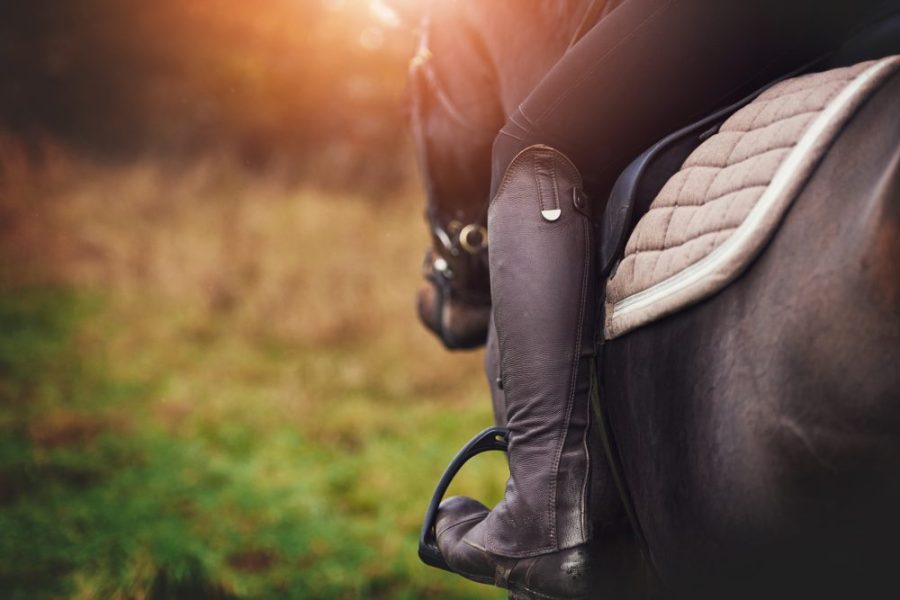When it comes to considering how much weight a horse can carry, the number on the scales is just one factor to consider.
There are many things to bear in mind when calculating whether a rider is a suitable size for a horse or pony and matching a jockey to an appropriate mount. These include features of both the rider and the horse, as well as the intended workload and use of the horse, plus the riding conditions, tack fit and more.
Assessing how much weight a horse can carry and what a suitable horse riding weight limit is for them is a complicated task, but one that should be addressed when you take care of a horse if equine welfare is to be prioritised.
Size rather than weight
Understanding whether a rider is an appropriate weight for their horse is a tricky and emotive topic, but one that is becomingly discussed more openly.
“It is not about whether a rider is fat or not, it’s about whether they’re riding a horse that is fit for the purpose required of it,” says Dr Anne Bondi, founder and director of The Saddle Research Trust.
“The terms ‘weight’ and ‘heavy’ are very emotive, and it’s important to focus on the recognised facts, not emotions.
“Tall riders are just as likely to have a negative impact, so I think we should talk about rider size, rather than rider weight.”
How much weight can a horse carry?
Dr Bondi devised a traffic light system to help assess whether a horse is carrying an appropriate load. The system uses the rider’s weight ratio, which can be calculated by dividing the rider’s weight (ideally including tack) by the horse’s, and expressing that figure as a percentage.
Green
For optimum performance (working close to or at its physiological limits without significantly increasing his risk of injury) and to be graded green, the horse should be carrying around 10% of their weight.
Amber
However, 15% is a much more common scenario, and this is graded amber.
Red
Horses carrying 20% of their weight are graded red as their welfare may be compromised.
“These guidelines are based on knowledge of the research that has taken place in this field to date, but these are my own views,” explains Dr Bondi. “We do not yet have scientific evidence for definitive figures due to the huge number of variables involved.
“There is concern about the message such ratios might give because it needs scientific basis, but it may be too complex to ever be able to provide accurate, suitable limits.
“In the meantime, the industry needs some guidance and I believe that this is a good place to start.”
Factors affecting horse riding weight limit
Dr Bondi stresses that each combination of horse and rider will have different criteria depending on their circumstances and that weight ratios must be considered alongside other important factors, including:
Horse age
If their musculoskeletal system is immature, or the horse is a veteran, they will be at greater risk of strain injury. The horse’s weight should be optimum.
Type of horse
The horse must have a strong enough physique if they are to carry extra weight. Cannon bone circumference can be used as a guideline, with the ideal ratio suggested as being 20cm per 455kgs of bodyweight.
Breed
Specific traits in certain breeds can offer an advantage in some circumstances. The Arab, for example, has efficient metabolic features and good running economy that may mean it can carry higher loads over longer distances more easily.
Conformation
A dipped back, for example, is a weakness that can put the horse at higher risk of strain, whereas a wider loin is believed to be desirable for endurance. The horse’s posture also affects efficiency.
Horse soundness
Some pathological conditions indicate a horse should be carrying easier (lighter) loads, which affects their horse riding weight limit.
Rider size
It’s not just a case of how much weight a horse can carry; the rider’s weight, height and the relative length of their limbs to their upper body all influence the horse’s performance through distribution of forces.
Rider skill
In a balanced posture in the centre of the saddle, the rider’s weight will be close to the horse’s centre of mass, and they’ll be more able to carry it. The unbalanced load, by being out of synchrony with the horse’s movement, is likely to increase peak forces.
Saddle fit
An incorrectly fitted saddle will adversely affect weight distribution on the horse’s back. The design should contribute to the avoidance of peak pressures by providing a large, smooth and soft bearing surface. The weight of the saddle should be included when considering a horse riding weight limit.
Horse fitness
Fitness and preparation is an important factor. Working on a variety of surfaces and terrain is needed to avoid repetitive strain injury.
Workload (intensity and type)
High impact activity increases forces exerted on the horse by up to twice its own weight, while longer distances and times make the horse more vulnerable to injuries.
Terrain
The effects of hill work on a horse are significantly higher than exercise on the flat, and energy costs increase as surfaces become more uneven. Environmental factors such as heat should also be considered.
Rider skill and horse riding weight limit
“If a rider is too tall for their horse, they could unbalance the horse much more easily and place excessive stress on the horse in the same way [as a too-heavy rider],” says equine vet and former BEVA president Lucy Grieve.
“Although a more skilled rider will be able to maintain balance more easily than an inexperienced one, and so reduce the risk of damage to the horse, the potential is still there and should not be ignored.
“Riders at any level should endeavour to be the appropriate weight for their horse and/or choose a horse which is appropriate for them, and be as fit and balanced as possible if they wish to avoid putting the horse under undue physical stress and therefore pain.”
Rider weight: the research
Some studies have inferred that increased rider weight is less influential than other factors.
A 1999 study — Relationship of body condition score to completion rate during 160 km endurance races — sought to find if rider weight influenced completion rate during 160km endurance races.
It found that of 360 horses, rider weight and rider weight ratio had no effect on overall completion rates among all horses.
It was also found that among the horses successfully completing the course, rider weight and rider weight ratio had no effect on finish time or placing.
Another paper, entitled Increased Rider Weight Did Not Induce Changes in Behavior and Physiological Parameters in Horses and published in 2020, evaluated the effect of increased rider weight (+15% and +25% of the regular rider’s bodyweight) on horse behavioural, physiological and gait symmetry parameters during a standard dressage test.
Data from 20 combinations was analysed and the researchers found that increasing the weight of the regular rider by 15% and 25% did not result in significant short-term alterations in the measured parameters.
They stressed that maximum rider:horse weight ratios were 15-23% and the exercise intensity was relatively low; thus the results should not be applied to other weight ratios and exercise intensities.
Workload and horse riding weight limit
High impact work can increase the risk of injury, particularly if coupled with a larger rider. Joint care is essential. Overloading a horse risks damage to support structures of the limb, and hyper-extension of the fetlock, due to the weight of horse and rider, plus the reaction forces of the speed or height of the jump.
“Horses carrying extra weight are more likely to sustain injury, tire more quickly and make mistakes,” explains Dr Bondi.
“This is not often taken into consideration, but mistakes can be fatal — for example in cross-country.”
While risks are increased by more demanding work, horses in light exercise should also carry an appropriate load.
Gentle hacking will have a lower impact on the horse, but if repeated long term with larger loading it can have a cumulative effect.
Signs that a horse is carrying too much weight
Dr Bondi refers to a list of behaviours that are likely to reflect musculoskeletal pain if eight or more are displayed.
“A study looked at the effects of different rider sizes and found that all the horses demonstrated increased behavioural markers with larger riders,” she says.
The behaviours include:
- Repeated changes of head position
- Head tilting
- Going in front or behind of the vertical for 10 seconds or longer
- Holding the ears back for five seconds or more
- Closing or half closing the eyes for more than a few seconds
- Frequent blinking
- Exposure of the white of the eye
- Exhibiting an intense stare
- Opening their mouths for 10 seconds or more
- Holding the bit to one side
- Clamping the tail
- Swishing the tail
- A rushed or slowed gait
- Hindlimbs not following the track of forelimbs
- Repeated changes of leg in canter
- Spontaneous changes of gait
- Repeated stumbling or toe dragging
- Sudden changes of direction
- A reluctance to move forward
- Rearing
- Bucking
“As a vet it’s become increasingly common for me to see overweight horses and, sadly, we know that the human population has been demonstrating the same trend,” adds vet Lucy Grieve.
“When we look at the effect rider size has on the horse, it can become a specific concern that we ought to be addressing.”
Awareness is growing
Awareness about how much weight a horse or pony can carry is growing. In showing, for instance, several organising committees have cracked down on larger adults competing on small ponies.
In 2022, Equestrian Australia revealed its ‘Guide to Horse Capacity’ to help gauge whether a rider is an appropriate size and weight for their mount.
Last year, The Suitably Mounted Group (SMG) launched a survey exploring the factors that should be considered when matching riders with horses or ponies.
The SMG’s Research Working Group, comprising Dr David Marlin, Dr Jane Williams and Lorna Cameron, devised the survey to capture the views of equestrians about which factors are the most important to consider when aiming to match riders with horses.
The results of the survey will be shared by Your Horse as soon as they are available.
‘There is a horse suitable for most riders’
However, there is still a lot to be done. Tony Tyler, deputy chief executive of World Horse Welfare, said riders must recognise that every horse has a finite maximum horse riding weight limit it can carry and beyond that discomfort and harm can occur.
“There is a horse suitable for most riders, and percentage guides are a good starting point, but we must also be aware that each horse needs to be treated as an individual,” he says.
“More research is needed on effects of rider size on the horse in the short- and long-term and, in the meantime, we must listen to our horses and be prepared to acknowledge and make changes if our size is negatively impacting on them in any way.’’
Find out more about The Saddle Research Trust
Related content
- How a horse’s joints work plus vet advice to keep them healthy
- Is it bad behaviour or could your horse be asking for help?
- How to check the fit of your saddle *VIDEO*
- What you need to know about bridle fit and horse head anatomy *VIDEO*
Main image © Shutterstock









